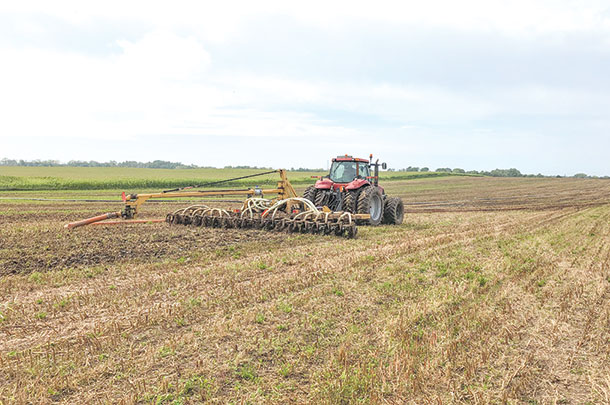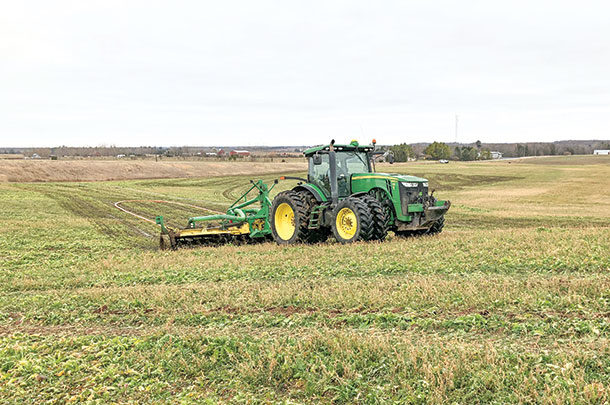“This idea of low-disturbance manure incorporation has some appeal from a water quality standpoint,” said Amber Radatz, ag and water quality program manager for Discovery Farms.
Particularly when looking at surface water runoff, Radatz said, “It’s intriguing, especially when we can use it right in combination with living roots and trying to cycle those nutrients more effectively at the surface.”
A panel of people using low-disturbance manure incorporation talked about the benefits and challenges they’ve seen with it at the Discovery Farms Conference in Wisconsin Dells, Wisconsin, in December.
As the Great Lakes Restoration Initiative coordinator for NRCS in northeast Wisconsin, Barry Bubolz has worked with several demonstration farms in watershed groups that are combining efforts to try new things and share what they’ve learned peer-to-peer.
He said soil health is a “ticket to fixing water quality.” When soil improvements are noticed on the farm, it pushes further adoption of those practices that also have a positive impact on water quality.
These practices include cover crops, alternative forages, planting green and interseeding. Integrating low-disturbance manure incorporation has expanded the utilization of these practices on dairy farms.
“From an NRCS standpoint, we don’t have a standard for low-disturbance manure application,” Bubolz said, but noted there are a few points they look at.
- It is not full-width tillage, as you want to limit soil disturbance.
- Application is made into a living crop or a cover crop.
- No more than 30% of the row width disturbance.
- A soil tillage intensity rating (STIR) value that is 20 or less in RUSLE 2.
“Ideally, if we can follow that up with a no-till planting, that tells me that our disturbance isn’t that great,” he said.
Aaron Augustian has used 100% low-disturbance manure incorporation along with 100% cover on all ground for the past two years on his farm in southern Kewaunee County, Wisconsin.
He dairies with his brother at Augustian Farms. They were moving 13 to 15 million gallons of manure a year, some in the spring and the majority in the fall.
“I feel that what we were doing in the past, we put all our nutrients on in one pass at 14,000 to 16,000 gallons; it wasn’t good for the soil health,” Augustian said.
Looking for something different, they joined the demonstration farms network where they could experiment with low-disturbance manure incorporation and cover crops.
Now, they establish a cover crop of rye following corn silage. They also put a multispecies cover crop on their 100 acres of wheat and following fourth-crop hay.
Following four years of heavy truck and tractor traffic chopping hay, Augustian will terminate the alfalfa with Roundup and 2,4-D before seeding in deep-rooted plants like turnips, radishes, ryegrass and clover.
“I just felt with our heavier clay soils, if we can get some more diversity, more root base into that soil, that seems to help us in spring,” he said. “The soil seemed a lot mellower planting into it than just the regular alfalfa roots.”
Once the cover crops are established, they will use low-disturbance manure incorporation to apply about 6,000 to 8,000 gallons per acre or what the soils can take at that time, and no more than 10,000 gallons an acre.
“We’ll do that in fall, and then we’ll come back in spring, and we’ll do the same thing on those fields,” he said.
With good weather last spring, they did not rut up fields and were able to plant 100% of the farm green.
“We didn’t use any tillage tools last year,” Augustian said. “That’s our ultimate goal.”
He has also been experimenting with interseeding. Last spring, he seeded a mix of clover, rye and vetch into 15% of their corn ground at the V3 to V4 stage.
Augustian said this worked well for them. With farmland 50 yards off the shore of Lake Michigan, their cooler weather helps in establishing the grasses and clovers.
“We’re going to move that up to about 40 to 45 percent [this] year, so it’ll alleviate the pain of trying to get rye in at the same time as chopping corn silage in the fall,” he said.
At Brey Cycle Farm in Sturgeon Bay, Wisconsin, Jacob Brey, his brother Tony and their families are focused on growing forages for their 700 dairy cows, youngstock, custom-raised heifers and beef cattle.
 Brey Cycle Farms in Sturgeon Bay, Wisconsin, applying manure after a cocktail forage harvest in September with winter triticale forage planting to be completed a couple of days later. Photo by Barry Bubolz, Wisconsin USDA-NRCS.
Brey Cycle Farms in Sturgeon Bay, Wisconsin, applying manure after a cocktail forage harvest in September with winter triticale forage planting to be completed a couple of days later. Photo by Barry Bubolz, Wisconsin USDA-NRCS.
“What we’ve been doing over the past three years, thanks to low-disturbance manure incorporation and cover crops, we moved to pretty much a double-crop system on all of our acres,” Brey said.
After corn silage or sorghum-sudangrass harvest, they immediately no-till in winter rye or winter triticale.
The triticale usually follows the sorghum-sudangrass (a forage they feed to their heifers) or the very first corn silage fields in September.
“We found that triticale needs to be in the ground a little bit sooner, kind of around when wheat needs to be established,” he said. Once that is seeded down, they switch to rye.
They are able to use a toolbar shared throughout the region to put about 9,000 gallons per acre of manure on those growing cover crops in the fall.
“There’s kind of a wide range of when we’re able to get that toolbar – one year it was September, last year it was in November, for example – but we found that the number one priority is to get the cover crop established first, to capture those last remaining growing degree units and heat days,” Brey said.
Instead of planting green into the cover crop like Augustian, the Breys harvest it in spring for cattle feed. Usually, the higher-quality triticale is fed to dairy cows as a replacement for alfalfa and the rye is fed to the heifers.
After the spring harvest around the end of May, they do another pass of low-disturbance manure incorporation, about 10,000 to 12,000 gallons per acre, before they no-till corn into that ground.
“What we’re trying to do is have a living cover crop on our ground pretty much every day of the year, if possible,” he said.
Pros and cons
Bubolz said winter rye has been a great practice based on timing manure applications and the amount of biomass that can accumulate.
Both Augustian and Brey said there is a wide window to apply manure on it – from not even sprouted to 4 inches tall or more.
“Rye is a pretty resilient plant,” Augustian said. “We haven’t had a whole lot of issues with burning it or running it down; it just snaps back.”
This helps him work better with his manure applicator’s schedule and whenever they can get there in the fall.
He used to wait for them to put the manure down first, then work the ground and plant the rye. Now he tries to have planting done before they arrive.
“It’s easier to go out there with the no-till drill right behind the chopper, get it in and then have those guys come in with their low-disturbance manure incorporation equipment. It works great, and then you’re done for the season,” he said.
Brey said he had to mentally adjust to seeing the manure toolbar going over a freshly planted rye field and worrying that he ripped up a new seeding. Come spring, though, he couldn’t even tell, as the rye mellowed out any bumps or ridges in the field over winter.
It is important to watch the seeding rates of rye if manure is to be applied, as it will really help with plant growth. While the biomass is an effective way to trap manure’s nutrients and can minimize soil damage, too much of it can be difficult to work with if trying to plant green in the spring.
Even though Brey removes the biomass, he also experienced some challenges planting last spring. They applied manure right after harvesting the rye and triticale, but then the ground turned very hard during a three- to four-week hot and dry stretch, which was a problem for getting enough down pressure on the corn planter.
Finding the right equipment for the manure application into cover crops has also been a struggle. The panelists talked about how some equipment didn’t work well given the solids content, sand bedding and targeted application rates.
“There’s probably not one toolbar that fits every circumstance,” Bubolz said.
Augustian and Brey are also educating their neighbors and community about this change in practice to let them know what they are doing and why.
“I think when they are seeing some of this manure sitting on top of the ground, we’re not getting it down there 3 or 4 inches, so there’s a question,” Augustian said.
Brey hosts a group of 10 to 15 people on their farm every May to talk to them about cover crops and manure applications, and his wife uses Facebook to explain what is happening on the farm.
“We really don’t have anything to hide,” Brey said. “We just need to tell the community and the public what we’re doing.”
While still experimenting and adjusting to weather challenges each year, these two farms have continued to adopt these strategies and expand the use across their farming operations for better soil health and water quality.
“It’s exciting to see the work that we’ve done the last five years, and it’s even more exciting to think about what we can do with the next five or 10 years,” Brey said.







